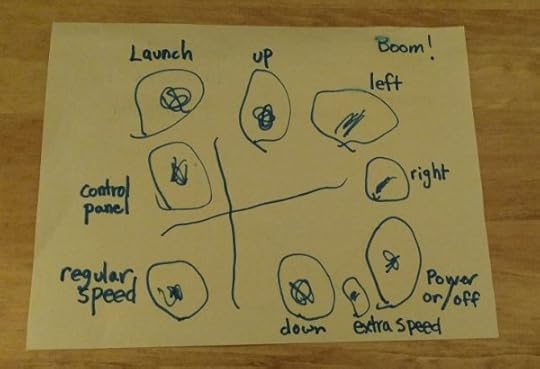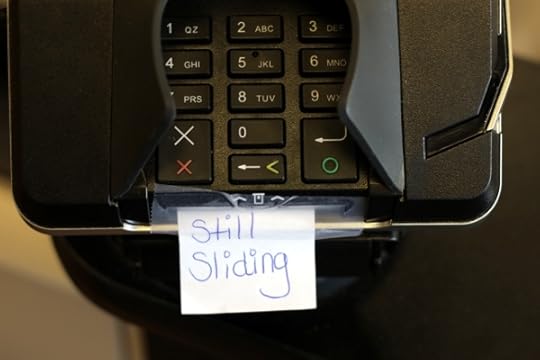Chad Orzel's Blog, page 12
February 8, 2016
Quantum Physics for Dogs at Jefferson Lab: TOMORROW
I’ve been remiss in my self-promotional duties, but I’m giving a public lecture tomorrow night in Newport News, VA, as part of the Jefferson Lab Science Series. This will be my traditional “What Every Dog Should Know About Quantum Physics” talk, with the sad addition of a slide honoring the late, great Queen of Niskayuna (visible as the “featured image” with this post). This isn’t the first dog-physics talk I’ve given since her death in December, but the previous one was the relativity talk, which has less Emmy-specific content. This one includes one of the video clips I made around a dog dialogue from the book:
That’s going to be a little hard to watch…
The talk was also written up in the local paper down there, which is always nice. And I’m looking forward to getting a tour of the JLab facilities. Assuming, of course, that the airline actually gets me there, which is no sure thing. Though my change of planes in Charlotte might be less of a problem than anticipated– I was fully expecting the Panthers to win big at the Super Bowl last night, and have their team plane come in at the same time as my flight…
Anyway, if you’re in that part of the world and free for the evening, stop by and hear some dog physics.
February 7, 2016
157/366: SteelyKid, Badass
We spent most of Saturday at a taekwondo tournament– the AAU Adirondack Championship, or some permutation of those words. This was held in the gym over at Hudson Valley Community College, and was fairly big:
The taekwondo tournmanet from way up in the bleachers.
It was, however, 99% waiting around. They did black-belt sparring in the morning, and said that staging for the colored belts would be at 1pm, so we were there at noon. But they did the forms competition before the Olymopic sparring (SteelyKid’s event), so it was 3:45 before they called her group to be sorted into age and weight divisions. So we spent the better part of three hours watching the kids from the Elite Team play elaborate tag games on and around the bleachers.
There was, however, some taekwondo action including several badass pictures while SteelyKid was warming up:

SteelyKid doing a round kick while warming up at the taekwondo tournament.
When she finally did get to fight, she finished second in her division, and got a big shiny trophy:

SteelyKid in sparring gear, with her second-place trophy.
Admittedly, she came second in a division of two (only one other girl of her age and weight at the tournament), but she fought gamely, and was very excited about the trophy. Which is probably best seen as a reward for the four-and-a-half hours of waiting around, rather than the two minutes of actual fighting…
Anyway, she’s awesome. Fear her.
156/366: Needles on the Roof
Random artsy shot from our back yard. This is the little bit of roof right over our back door. It’s the only bit of roof left on the house that’s asphalt shingle– the main roof was always slate, and we got the bit of shingle above the garage replaced with fake slate not long after we bought the house. As a result, it collects crap in a way that the other bits don’t. But it looks kind of cool and decrepit:

Pine needles and moss on the small roof over our back door.
Or maybe not. I dunno. Anyway, I noticed it, and it looked cool to me, so I took a photo.
155/366: Boom!
A few days ago, The Pip came home with a “present” for me and Kate, wrapped up in construction paper. This turned out to be another sheet of paper, which is actually a launch control panel:

The Pip’s rocket control panel. (One of his teachers wrote the words for him…)
The layout of the “buttons” is all him, but he got one of his teachers to do the labels. On the other side, it says “The missle will launch in one minute,” which I assume he also dictated.
He’s got a rich inner life…
February 5, 2016
Back-of-the-Envelope Calculation: Reaching Gender Equality in Physics Faculty
In yesterday’s post about the lack of money in academia, I mentioned in passing that lack of funding is part of the reason for the slow pace of progress on improving faculty diversity. That is, we could make more rapid progress if we suddenly found shitloads of money and could go on a massive hiring binge, but in the absence of flipping great wodges of cash, change comes more slowly.
This, naturally, sparked a sort of morbid curiosity about whether the scale of this problem would be quantifiable, and of course, there’s the AIP Statistical Research Center offering numbers on all sorts of features of the physics landscape. So, here are some numbers about what it would take to achieve equal representation for women within physics departments. These are grabbed from reports spread over a few years, so I’m going to aggressively round numbers, usually up, because the goal here is just to give a sense of the scale, not a precise prediction of anything.
So, according to a recent-ish report on the number of faculty jobs (pdf) there were about 9,400 physics faculty in the US, and 80% of those are on the tenure track. From the report on women in physics (pdf), about 14% of those are women.
Aggressively rounding these, that’s 7600 tenure-track faculty, 6500 men and 1100 women. Which means we’d either need to replace 3700 men with women to achieve the goal of equal gender representation, or create 5400 new faculty positions to be filled exclusively with women.
Assuming this replacement were to take place via the normal retirement/replacement process, how long would that take? Well, the AIP has a report on faculty turnover (pdf), which suggests we could ballpark the number of jobs on offer in a given year as about 600. Which means it would take a bit more than six years of exclusively hiring women into physics faculty lines to get to equal representation.
Leaving aside the massive legal issues with such a program, is that even feasible? Well, the report on graduate degrees (pdf) says that in recent years there were about 1900 Ph.D.’s in physics awarded per year, and around 20% of those went to women. Which we can aggressively round to about 400 women per year, so the “hire only women” plan would require hiring half again as many women per year as graduate with a Ph.D. in physics. If you just hired every woman who got a Ph.D. directly into a faculty job, it’d take a bit more than nine years to get to equal representation.
(Of course, this isn’t a really accurate representation of the job market, as there are a large number of recent-ish graduates in post-doc jobs, so there’s a larger reservoir of talent available right off. I don’t know how to quantify that, though, and again: I’m just trying to get a sense of scale, here…)
And just for giggles, what would the “shitloads of money” option require? Well, a few years back I recall the administration saying that they needed a donation of about $2 million to endow a faculty line. That’s a few years out of date, but then we pay a bit better than the median for faculty, and full professors in endowed chairs make more than new hires. So it’s probably not completely ridiculous to use as a number for sense-of-scale purposes.
So, if you wanted to just make the gender-equity problem disappear overnight by creating a huge number of new faculty lines exclusively for women, you’re talking about 5400 jobs at $2 million apiece, or just shy of eleven billion dollars. (Leaving aside the logistical question of who would fill all those jobs…)
So there’s some back-of-the-envelope math for you. This was undertaken mostly to satisfy my morbid curiosity from yesterday, and has basically confirmed said curiosity as morbid. You could do something similar for astronomy departments, but I don’t care enough to repeat it; you could also try to do a similar calculation for getting to proportional representation of racial diversity, but the numbers there are really depressing, so I’m not even going to look.
Again, the point here, as with all back-of-the-envelope calculations, is just to get a sense of scale. I’m not making a specific policy recommendation, or anything like that. Though if you do happen to have $11 billion burning a hole in your offshore bank account, drop me a line, and I’ll be happy to make some suggestions…
Physics Blogging Round-Up: Gravity, Pigeonholes, Groundhogs, and Weirdness
A long-ish stretch of time, but I was basically offline for a bunch of that because I needed to finish a chapter I was asked to contribute to an academic book. So there are only four physics posts from Forbes to promote this time:
— ‘The Expanse’ Is A Rare Sci-Fi Show That Gets Simulated Gravity Right: Another post on the SyFy adaptation of “James S. A. Corey”‘s books, talking about a nifty bit of visual effects that nods at the Coriolis force you’d see on a rotating space station.
— What Is The Quantum Pigeonhole Principle And Why Is It Weird?: A paper published in the Proceedings of the National Academy of Sciences got some press with claims that you can put three quantum particles in two boxes without having any two particles together. Digging into it more, it’s both less and more weird than that description.
— Groundhog Day Physics: Four Stories You Hear Over And Over Again: In honor of our dippiest public holiday and a great Bill Murray movie, some physics stories that repeat regularly enough that you might be forgiven for thinking you were stuck in a time loop.
— How Do You Deal With Quantum Weirdness?: An attempt to explain the two major groupings of interpretations of quantum physics.
I’ve got a bunch of travel coming up (about which more soonish), so blogging will remain a little sporadic, but hopefully not as comprehensively silent as I was for the last week or two of January.
February 4, 2016
154/366: Parking Lot Sunset
Early in this photo-a-day thing I tried to get in the habit of bringing the camera with me when I ran errands, to get pictures of random interesting stuff outside of the immediate neighborhood of our house. I fell out of that, though, when it was actually cold, because I didn’t like leaving the camera in the car in freezing temperatures.
I had it with me last night, though, because I was taking SteelyKid to Odyssey of the Mind practice. Which was good, because while we were getting our traditional fast-food dinner beforehand, there was a really cool-looking sunset:

Sunset over Niskayuna.
There’s basically no way to get a good sunset photo from within our neighborhood, but this is a little ways away, and on a bit of a hill, so has a relatively clear horizon. So, check it out: pretty colors!
153/366: Old School
Here in the US, we’re slowly transitioning to the European system of chip-based credit cards (I got email at work saying that my new card there will actually be chip-and-PIN, wonder of wonders). This is not uniformly distributed yet, though, so about half of the retailers I deal with regularly want the chip, the other half want the old-school swipe. If you guess wrong about a particular store, the terminal will blat loudly and annoyingly at you, so I end up asking cashiers all the time “Are you guys doing the chip thing yet?”
One local store apparently got sick of that, and modified their terminals with Post-It notes:

Credit-card terminal at the Niskayuna Co-Op.
(I took this when I brought my camera with me on the walk to the store to pick up a few things– trying to replace a little of the exercise I’m no longer getting with Emmy gone. The other thing I took a bunch of photos of on the way was old-school rooftop TV antennas. It’s a theme!)
(I thought I had queued this to publish yesterday, but I was apparently wrong…)
Everything Would Be Better With Shitloads of Money
Over in Twitter-land, somebody linked to this piece promoting open-access publishing, excerpting this bit:
One suggestion: Ban the CV from the grant review process. Rank the projects based on the ideas and ability to carry out the research rather than whether someone has published in Nature, Cell or Science. This could in turn remove the pressure to publish in big journals. I’ve often wondered how much of this could actually be drilled down to sheer laziness on the part of scientists perusing the literature and reviewing grants – “Which journals should I scan for recent papers? Just the big ones surely…” or “This candidate has published in Nature already, they’ll probably do it again, no need to read the proposal too closely.”
And, you know, I sympathize, at least to a point. Paper-counting is dumb, and impact-factor-weighting is even sillier. But then, there are a lot of problems with this idea, most of them tracing back to the fundamental fact that there isn’t enough money to go around.
That is, yes, in an ideal world, you would give out grants on the basis of “the ideas” in some abstract sense. But there are lots of people with cool ideas out there, and a pretty large fraction of them even have “the ability to carry out the research” (we’ll assume for the moment that there’s some sensible way to establish that ability without a CV). But we’re in a world where grant approval rates dip toward single-digit percentages, so a bunch of those people aren’t going to get funded. So we end up accreting stupid criteria for approval, just because you need to do something to cut the pool down.
And this happens in all sorts of places in academia. There are all sorts of factors that get used in academic hiring that are problematic to various degrees, the classic example being the nebulous catch-all of “fit,” but that happens because there isn’t enough money to hire everyone who deserves a job. When you’ve got 200 people applying for a single tenure-track job, good people are going to get left out through no real fault of their own. And the sloooow progress on faculty diversity has similar roots– I’m sure that if you gave the administration of the University of Missouri the money to hire 400 new faculty and staff they would be thrilled to make their racial diversity problem go away. But nobody in academia has the money to do that.
Absent a sudden influx of astronomical amounts of cash, I don’t know what realistic options there are to do a better job with allocating the limited resources we do have. At some level, it would probably be just as fair and effective to distribute grant funding by filtering out the small number of totally unqualified people and then rolling dice to determine the lucky folks who actually get funding. I doubt that’d make people any happier, though. For faculty positions you’d probably need to combine random number generation with massively illegal collusion, to make sure that the same handful of superstars don’t get offered all the jobs.
I’m sympathetic to the concerns of the open science community, and more generally to concerns about the absurd pressures placed on junior faculty. But most of the things people propose as solutions would need the sudden appearance of shitloads of money to work out as intended, and that’s just not happening.
And on that depressing note, I’m going to go edit some photo-of-the-day pictures.
February 2, 2016
152/366: Fun With Motion Blur
This one was a whole bunch of work for one smallish shot…
So, in past rounds of “science-y things with my fancy camera,” I looked at the effect of ISO settings and apertures. This time out, I wanted to look at something moving, and the way that it blurs with increasing exposure time.
My initial thought was to try to take pictures of a falling ball, but it’s too hard to get that to work consistently without setting up some kind of electronic trigger, and I wasn’t willing to do that. But, of course, a swinging pendulum will always be in a relatively narrow range of positions, making it a better moving target.
So, the composite below is a bunch of shots of a yo-yo hung from the ceiling in our basement, swinging back and forth. The focus was set to manual, the f-stop maxed out, and I adjusted the shutter speed and ISO level to get approximately the same exposure each time. I got it in nearly the same position each time by the simple expedient of holding down the shutter button in continuous shooting mode and hoping for the best.

Composite of a swinging yo-yo shot with different exposure times.
The colors are kind of wonky because I couldn’t find the dark blue plastic yo-yo we have somewhere, only one that’s clear plastic with writing on it. At the longer exposures, that’s blurred out enough to be nearly invisible without cranking the contrast way up.
I may re-do this at a later date, just to get cleaner images, but this is a decent proof-of-principle for the effect I wanted. It’s kind of impressive to me how fast the shutter can be and still produce significant blurring– this is only moving at a few meters per second, and yet there’s very definite blurring at a shutter speed considerably higher than the standard video frame rates.
Anyway, that was fun. And as a bonus, it explains why so many of my photos of the kids look kind of fuzzy…
Chad Orzel's Blog
- Chad Orzel's profile
- 89 followers



